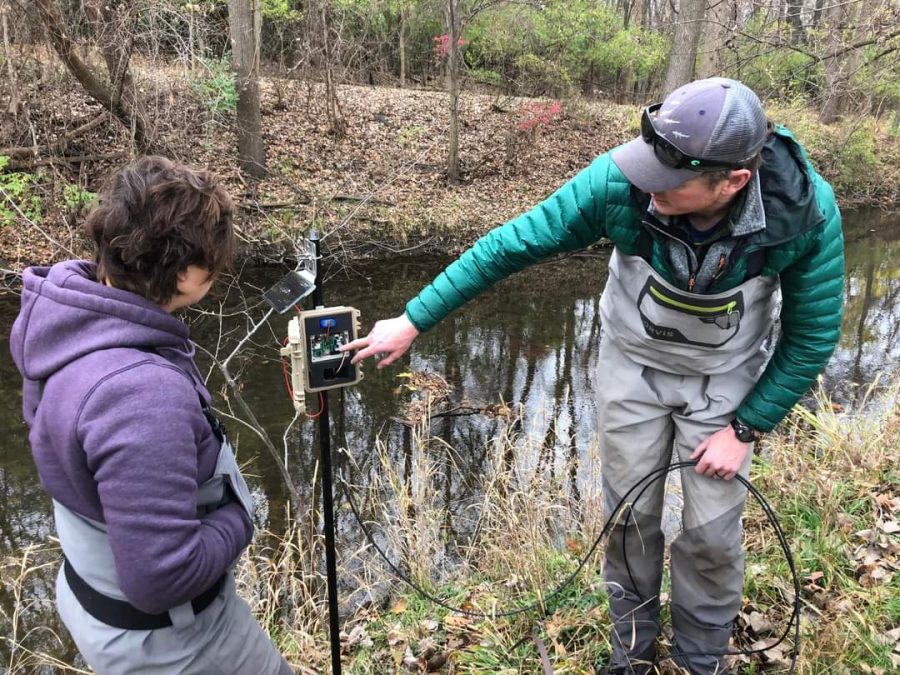Long before West Michigan had been settled by white Americans or Dutch immigrants, there was a creek that fed into a larger, faster-flowing river. The Ottawa tribe called the creek “Ken-O-Sha” — which means “water of walleye” — and the river “O-wash-ta-nong,”which means “far-flowing water,” according to a soon-to-be-published paper by Calvin professors Dave Warners and Gail Heffner, which the Chimes has been granted permission to use.
Today, that creek, now known as Plaster Creek, is almost unrecognizable. The creeks’ headwaters flow from Dutton Shadyside Park — a Kent County Park midway between Kentwood and Caledonia — and meet the river now known as the Grand River near where Market Avenue meets I-196. Agricultural runoff, road salt and a concoction of industrial chemicals spill into the creek’s waters every day as it passes through the metropolitan Grand Rapids area.
However, since 2009, the Plaster Creek Stewards — an initiative formed by Heffner and Warners — have been working to restore the Plaster Creek Watershed following community concerns about water quality in the area. The initiative now includes research, community education and restoration projects which involve faculty and students from Calvin as well as several other local organizations such as Kent Conservation District, the Christian Reformed Church in North America (CRCNA) and the West Michigan Environmental Action Council (WMEAC), among others, according to Calvin’s website.
A watershed in decline
The renaming of Ken-O-Sha to Plaster Creek and its current pollution are closely intertwined stories. In the mid-1800s, European-American missionaries and settlers discovered gypsum — a key component in the production of plaster — in what is now the Grand Rapids area. This led to the formation of a plaster mining industry near the Plaster Creek Watershed, as well as the disappearance of the walleye for which the creek has been named, according to Heffner and Warner’s paper.
The Plaster Creek watershed starts in the rural countryside of Dutton, MI, and empties out into the Grand River in a densely-populated urban area. The demographic upstream is rural, economically well-off and predominantly white, while the demographic downstream is urban, low-income and ethnically diverse. Those downstream experience worse living conditions than those upstream. While the story of Plaster Creek reveals broken relationships between humans and nature, it also reveals broken relationships between humans and themselves, according to the paper.
It was in this context that plans to take action started to develop in the early 2000s.
The formation of Plaster Creek Stewards
In the early 2000s, Heffner, a social scientist specializing in urban studies, and Warners, a botanist and ecologist, took note of community concerns regarding water quality in the area. According to a 2002 document from the Michigan Department of Environmental Quality (MDEQ), biological assessments of the section of the creek downstream from Breton Ave had indicated “poor biological communities” since the 1970s. This led to the development of Plaster Creek Stewards, officially launched by Calvin in 2009, which sought to develop projects to restore the Plaster Creek Watershed.
One of these projects — based around the creek’s head in Kent County’s Dutton Shadyside Park — aimed to mitigate drainage from a nearby parking lot. The original plan, according to the paper, was to develop a bioswale — a biological “buffer-zone” of sorts — that can filter water before it enters the creek.
However, with the large volume of runoff that would come from this parking lot, concerns were raised that the bioswale would be easily overwhelmed. For this reason, the scope of the project was subsequently expanded –– to the whole of Shadyside Park, according to the paper.
Renovating Shadyside Park
The project –– which would span 12 acres of public land, and was granted $600,000 from the MDEQ, according to Heffner and Warners’ pre-publication paper – would be no easy feat. For a project of this size, the Plaster Creek Stewards were required to notify the public. Not everyone was immediately smitten with the idea after the public was notified in 2016, according to Warners.
“I realize, in hindsight, that I was really naive thinking that, ‘oh, yeah, everybody’s gonna love it if we’re moving into some place and helping the stream. Everybody’s gonna love us. They’re gonna treat us like heroes,’” said Warners.
Very quickly, rumors spread –– by flier, by Facebook post and by word of mouth –– that claimed these renovations would harm the community, according to the paper. “I think, altogether, it was delayed three years, because there was a court case and they wanted to hold it up. There were more hearings, and that sort of thing,” Warners told Chimes. “As this was eventuating, we were told by the state that they would think nothing less of us if we just decided to abandon it, because it’s been too much trouble.”
Additionally, this project was college-administered, government-funded and environmentally focused. “Not everybody trusts academics, and not everybody trusts environmentalists. And we were both,” said Warners.
These circumstances, according to Warners, only “caused [him] to dig [his] heels in even more.” Warners and his colleagues went ahead with the project, completing the renovations to Shadyside Park after multiple years of delays. By the end of the project, public resistance had mostly dissipated, according to Warners.
Reflecting on the challenges faced
Warners said Plaster Creek Stewards learned a lot from the experience. “There’s a lot we would have done different, and there’s a lot of things that we are doing different right now because of those lessons that we learned,” said Warners.
One lesson was the complex human dynamics that can go into ecological restoration projects. According to Warners, there were many different groups involved in the Plaster Creek Watershed, including “rural residents who are suspicious of the government, downstream residents who blame upstream residents for causing problems and farmers who distrust academics.”
Greater effort has since been made regarding community outreach in areas that could be affected by Plaster Creek Stewards projects sometime in the future.“We’re really excited about some of the potential work in the Roosevelt Park neighborhood, which is a largely Hispanic neighborhood in the downstream part of the watershed,” Warners said. “And last year, this time of year, the Roosevelt Park neighborhood had a trunk-or-treat event, where different organizations would come out with Halloween candy for kids, and it was in the park. We were part of that. We had our Plaster Creek stewards truck there and our Plaster Creek stewards staff there because we wanted people to see us, to get to know us, to learn to trust us.”
Some in the community who were initially resistant to the Dutton Shadyside Park project have since expressed other options. One local resident, who identified herself as Amy B., wrote a letter to the Plaster Creek Stewards some time after the project’s completion thanking the Plaster Creek Stewards. In the letter, the resident wrote, “Now that the project is complete, I can see the great improvement to the park.”








